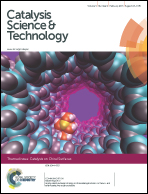A computational study on the hydrogenation of CO2 catalyzed by a tetraphos-ligated cobalt complex: monohydride vs. dihydride†
Abstract
Density functional theory (DFT) calculations were used to study the mechanisms of hydrogenation of carbon dioxide catalyzed by the tetraphos-ligated (PP3: P(CH2CH2PPh2)3) cobalt complexes. We investigated the binding modes between CO2 and the cobalt metal center to determine whether the CO2 coordinated to the metal center in the catalytic processes. The monohydride catalytic pathway (Path I) and the dihydride catalytic pathway (Path II) for the hydrogenation of CO2 have been explored. In these two cases, a weak H⋯CO2 interaction leads to cleavage of the Co–H bond and subsequent formation of the formate ligand. Moreover, the transformation from the dihydride to the monohydride is endergonic by 9.2 kcal mol−1 and the relevant free energy barrier is about 20.9 kcal mol−1. However, the largest free energy barrier of 19.1 kcal mol−1 in Path II is significantly lower than that in Path I (22.8 kcal mol−1), which corresponds to the hydride transfer from the cobalt center to CO2. The detailed comparisons of the possible pathways suggest that Path II is much more favoured than Path I and that it is not necessary to form the monohydride species in the whole catalytic cycle. Our results, which unambiguously demonstrate that the active catalyst is the dihydride rather than the monohydride, are consistent with the experimental observations and, most importantly, provide detailed mechanistic insight.


 Please wait while we load your content...
Please wait while we load your content...